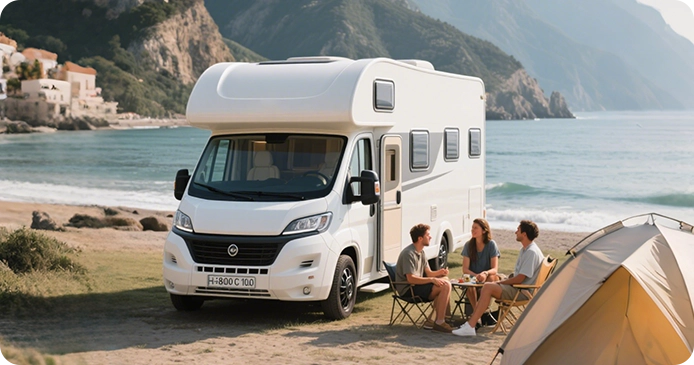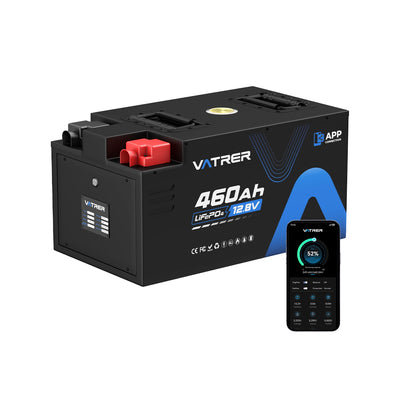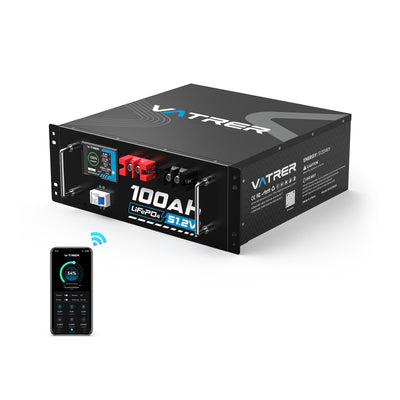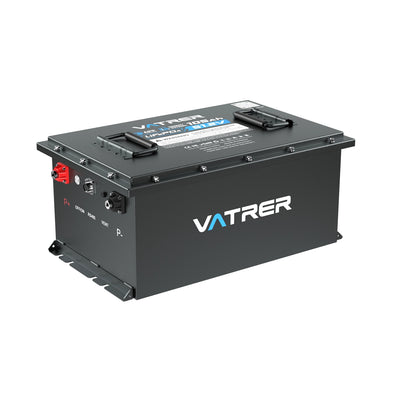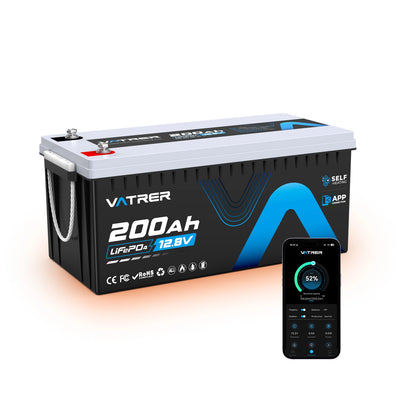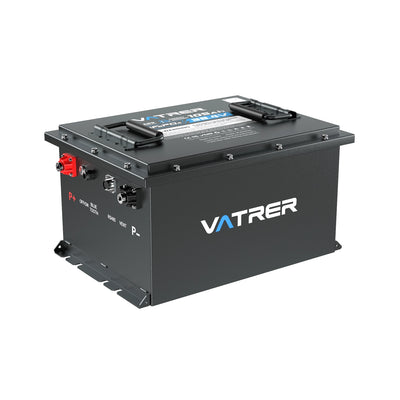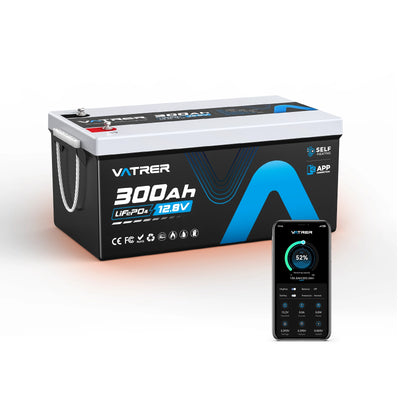Lithium batteries are widely recognised for being lighter, more efficient, and longer-lasting than conventional lead-acid batteries. However, this more advanced chemistry is also more sensitive to the way the battery is charged, discharged, and used in everyday operation. If a lithium battery is pushed beyond its limits – overcharged, excessively discharged, or subjected to extreme temperatures – it can suffer irreversible damage or, in the worst case, enter thermal runaway, a rapid overheating process that can end in complete failure.
For this reason, every modern lithium pack requires a Battery Management System (BMS), effectively the “control unit” that keeps the battery safe, efficient, and dependable. A lithium battery BMS continuously supervises the battery pack, ensuring each cell remains within safe operating limits while also optimising performance and service life.
What Is a BMS and How Does It Work
A Battery Management System (BMS) is an electronic control system integrated into, or attached to, a rechargeable battery pack. It constantly measures key values such as voltage, current, temperature, and the overall condition of the individual battery cells.
Put simply, the BMS keeps track of each cell, determines safe limits for charging and discharging, and manages how energy flows into and out of the battery pack. When abnormal conditions are detected – for example over-voltage, excessive temperature, or a short circuit – it intervenes immediately, either by disconnecting the current or adjusting the power.
You can think of it as a central monitoring and control hub that prevents incorrect use and shields the battery from unsafe operating conditions. Without this layer of protection, even the best lithium battery could age rapidly or fail in a severe and sudden way.
Core Functions of a Battery Management System
A BMS usually delivers three key functions: Monitoring, Protection, and Optimisation. Together they ensure your lithium batteries remain safe while performing at a consistently high level.
1. Monitoring — Real-Time Health Check
The BMS constantly monitors several core parameters:
Voltage: keeps each individual cell within its permitted operating window.
Current: avoids excessive current draw during charging and discharging.
Temperature: supervises temperatures to prevent charging when it is too cold or discharging when it is too hot.
State of Charge (SOC): indicates how much usable energy remains in the pack.
State of Health (SOH): reflects how the battery has aged and how much capacity it has retained.
With this information, the system knows precisely when to limit or stop charging and discharging before lasting damage occurs, keeping operation safe and stable.
2. Protection — Preventing Damage and Hazards
One of the BMS’s most important roles is to act as a safety barrier. It stops harmful situations such as overcharging, deep over-discharge, and short circuits that could otherwise destroy the battery pack.
Protection Type
What It Does
Why It Matters
Overcharge / Over-Discharge
Interrupts charging above a safe voltage or discharging beyond a safe depth.
Prevents cell swelling, gas formation, and chemical instability.
Short Circuit Protection
Detects very high, sudden current peaks and disconnects power immediately.
Reduces the risk of fire and thermal runaway.
Temperature Control
Limits or stops charging outside the safe temperature band (typically 32°F–113°F).
Prevents lithium plating at low temperatures and failures due to overheating.
Tips: Never bypass or tamper with a BMS in an attempt to achieve “extra power”. Doing so disables essential safety features and will invalidate any warranty.
3. Optimization — Smart Balancing and Efficiency
As batteries age, individual cells can drift slightly out of sync because of self-discharge and wear. A BMS restores balance by equalising the cells, keeping their voltages and capacities as closely aligned as possible.
Two main balancing approaches are used:
Passive Balancing: excess energy in higher-voltage cells is dissipated as heat until they match the lower cells.
Active Balancing: surplus charge is transferred from fuller cells to emptier ones, improving overall efficiency.
Well-balanced cells enhance performance, increase usable capacity, and slow down degradation, enabling the battery to deliver stable power for many years.
Maintaining the Optimal Temperature Range of the Lithium Battery BMS
Temperature is one of the most decisive factors for battery longevity. A robust BMS supports the battery in staying within an ideal temperature band, avoiding both excessive cold and excessive heat.
At low temperatures (below 32°F), charging can lead to metallic lithium plating on the anode, which permanently reduces capacity and can create safety concerns. At high temperatures (above 113°F), efficiency can drop by up to half and the battery ages much more quickly.
Modern systems therefore integrate thermal management strategies such as:
Passive cooling using airflow or heat-conducting materials.
Active cooling via fans or liquid-based cooling circuits.
Self-heating functions in cold conditions to bring the cells up to a safe temperature before charging starts.
Keeping the battery in this “Goldilocks zone” maximises efficiency, safety, and cycle life.
Types of Battery Management Systems
Depending on the application, different BMS architectures are used. The table below summarises several common battery management system types used today:
BMS Type
Description
Key Advantage
Trade-Off
Centralized
One central controller supervises all cells directly.
Straightforward design and relatively low cost.
Requires extensive wiring and is less convenient to service.
Modular
Each module looks after a group of cells, coordinated by a main controller.
Easy to expand and maintain in stages.
Slightly higher overall system cost.
Primary/Subordinate
A main BMS performs control logic, while subordinate units gather data.
Offers a good compromise between cost and control.
Relies heavily on the stability of the primary controller.
Distributed
Every cell has its own small BMS board attached.
Very accurate monitoring with reduced cabling.
More expensive and more complex to repair.
Built-in BMS
Fully integrated inside the battery housing.
Compact design and easy, plug-and-play installation.
Less flexibility for very large or highly customised systems.
Why BMS Is So Important for Lithium Batteries
Safety Above All
The BMS acts as the main safety layer against critical incidents. By enforcing boundaries on voltage, current, and temperature, it helps prevent thermal runaway, fire, and damage from short circuits, protecting both the battery pack and the people using it.
Consistent Performance and Range
Thanks to intelligent monitoring and control, the BMS keeps voltage and state of charge in balance, providing stable power output even as the cells get older. Your equipment or vehicle therefore maintains predictable performance and range over time.
Extended Battery Lifespan
Every protective measure — from cell balancing to thermal management — contributes directly to longer life. A high-quality BMS helps lithium batteries achieve thousands of charge cycles with only gradual capacity loss.
Real-Time Diagnostics and Communication
More advanced systems offer Bluetooth or CAN communication, enabling users to view performance data, temperature, and charge status in real time via apps, displays, or integrated control systems.
Lower Total Cost of Ownership
Although a BMS adds some cost at the outset, it significantly reduces long-term expenses arising from early failures, replacements, and warranty issues, making it a sensible investment in any serious energy system.
How To Choose the Right BMS
When selecting a BMS for your lithium system, pay attention to the following:
High-precision sensors for voltage, current and temperature.
Robust protection against over-charge, over-discharge, and low-temperature charging.
Reliable cell balancing for long-term stability.
Compatible communication interfaces (such as CAN or RS485) for use with solar inverters or EV systems.
Documented testing and quality assurance from a trustworthy manufacturer.
Tips: Avoid very cheap, untested BMS products. Poor calibration or slow reaction can lead to irreversible cell damage or unsafe conditions.
Common Problems with Low-Quality BMS Units
A poorly designed or faulty BMS can actually put your system at risk. Typical issues include:
Inaccurate measurements that fail to detect dangerous voltage or temperature spikes.
Delayed response to faults, so over-current or overheating is not stopped in time.
Ineffective cell balancing, which reduces usable capacity.
Unnecessary shutdowns that disconnect power even though the battery still has energy available.
Total failure to protect in critical conditions, increasing the likelihood of thermal runaway.
In short, the reliability of your BMS largely determines how reliable your entire energy system will be.
Conclusion
A battery management system BMS is not an optional extra; it is the core of any modern lithium-based power solution. By protecting the cells, keeping them in balance, and avoiding permanent damage, it ensures your lithium batteries stay powerful, safe, and trustworthy over the long term.
Looking for a straightforward, ready-integrated solution? Vatrer's lithium batteries include a robust built-in BMS with accurate sensing, intelligent balancing, and comprehensive protection against over- and under-voltage, over-current, extreme temperatures, and short circuits. This combination delivers dependable power, app-level insight, and strong safeguards that protect your investment for years to come. Whether your system powers an RV, a golf cart, or a solar installation, Vatrer’s smart BMS architecture supports a longer service life, stable energy supply, and real peace of mind.
FAQs
If my charger already has protections, do I still need a BMS?
Yes. A charger can limit voltage and current for the battery pack as a whole, but a battery management system (BMS) works at individual cell level and provides continuous oversight of each cell’s voltage, temperature, and state of charge (SOC). That detailed, cell-by-cell monitoring is what prevents hidden imbalances and local overheating that a charger cannot detect. In addition, the BMS provides short-circuit protection, temperature cut-offs, and controlled shutdown logic, which are essential during both charging and discharging. Put another way: the charger manages how the tank is filled; the BMS protects the contents of the tank itself.
How do I size and choose the right BMS for my system?
Start by matching the BMS to your cell chemistry (for example LiFePO4), nominal system voltage, and realistic power requirements. Consider your inverter or controller’s maximum power draw and the surge behaviour of your loads. For instance, a 2000W inverter on a 12V system can require around 167A continuously (2000W/12V). Select a BMS with a continuous current rating comfortably above that figure and a surge rating that can handle motor or compressor start-up currents. Prioritise accurate measurement, robust cell balancing, low-temperature charge protection, and communication (Bluetooth, CAN, or RS485) if you want app monitoring or coordination with inverters and MPPT controllers. For compact setups, a battery with an internal BMS is usually plug-and-play; for larger banks or rack systems, a modular or master/subordinate design is often more suitable.
What actually happens when a BMS “shuts down” and how do I recover?
When a limit is exceeded – such as low voltage, high temperature, or excess current – the BMS opens its protection MOSFETs and effectively turns the pack off to prevent permanent damage. Recovery depends on the type of fault. After a low-voltage cut-off, connect an appropriate charger to wake the pack and begin charging gently. If the trigger was over-temperature, allow the battery to cool down (or warm up if it was too cold) before trying again. For over-current events, remove or correct the problematic load and then power-cycle the system. If shutdowns happen repeatedly, check for underlying issues: undersized cables, loose connections, incorrect charger settings, or a malfunctioning device.
Tip: Many recurring problems are linked to incorrect charging parameters, so always confirm that your charger profile matches LiFePO4 specifications and the BMS’s maximum voltage limits.
Can I use lithium batteries in cold climates without harming them?
Yes, provided suitable safeguards are in place. Charging below freezing can cause lithium plating, so a quality lithium battery BMS will block charging until the cells reach a safe temperature. Practical solutions include packs with integrated heaters, preheating using shore power or a DC-DC source, insulating the battery compartment, and scheduling charging for the warmer part of the day. For storage, keep the battery around 40–60% SOC and avoid prolonged exposure to extreme cold or heat.
Tip: If your location frequently experiences sub-zero mornings, consider a Vatrer battery with a built-in BMS and self-heating function so the pack can pre-warm itself before accepting charge.
How does cell balancing work, and when is active vs. passive balancing worth it?
Over many charge and discharge cycles, small differences cause cells to drift apart in voltage. Cell balancing brings them back into alignment so that no single cell limits the performance of the whole pack. Passive balancing gently bleeds off a small amount of energy from higher-voltage cells near the top of charge; it is simple and robust, and more than adequate for most RV, marine, and residential solar systems. Active balancing moves charge from stronger cells to weaker ones, which can be beneficial in large or high-cycle fleets where extracting maximum usable capacity is a priority. After installing a new pack or adding modules, allow several full charge cycles so the BMS can complete balancing; during this phase, overall performance may gradually improve as the top-of-charge point is harmonised.
What communication should I look for Bluetooth, CAN or RS485 and why?
Bluetooth is ideal for quick access via a smartphone or tablet, giving you an easy view of SOC, temperatures, and cycle count. CAN and RS485 support more advanced integration, allowing the BMS to exchange data with inverters, chargers, and solar controllers so the entire system can respond dynamically (for example by reducing charge current or discharge power as limits are approached). Off-grid and vehicle applications often benefit from CAN-based communication for closed-loop control, while fixed storage and rack systems frequently use RS485 for longer cable runs and stable networking. Choose a BMS that communicates in the same protocol as your inverter or MPPT to avoid incompatibility and nuisance alarms.
How do I minimize the risks of thermal runaway and electrical faults?
Start with a high-quality BMS and never bypass its protections. Size cables and fuses correctly, use proper crimping and torque settings, and secure wiring to prevent damage from vibration. Keep the pack within its recommended temperature range using ventilation, ducted air, or liquid cooling where power density is high. Configure voltage and current limits according to the cell chemistry, and enable low-temperature charge lock-out. Physically separate high-current cables from low-voltage signal lines to reduce electrical noise and false triggers.
Tip: If your BMS records event logs, review them periodically. Repeated warnings for high temperature or over-current are early indicators that something should be corrected before it escalates.
Should I choose a built-in BMS battery or an external BMS system?
For most RV, marine, golf cart, and small home-solar installations, a battery with an integrated BMS is the easiest and safest route – fewer components to wire, and the manufacturer has already matched the BMS to the cells. External or rack-level BMS solutions are better suited to larger commercial storage systems, where advanced data logging, tailored limits, and many parallel strings are required. If you are not building a multi-cabinet installation, a built-in BMS is usually the most practical choice.




































